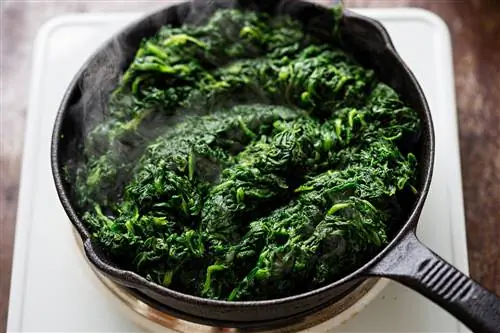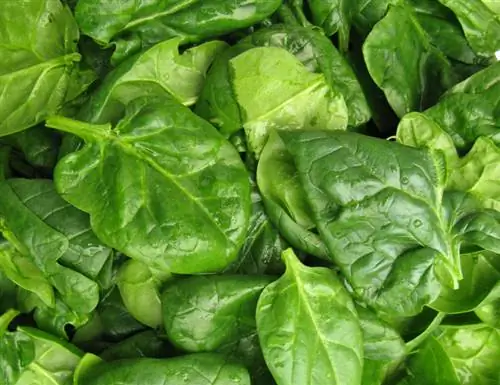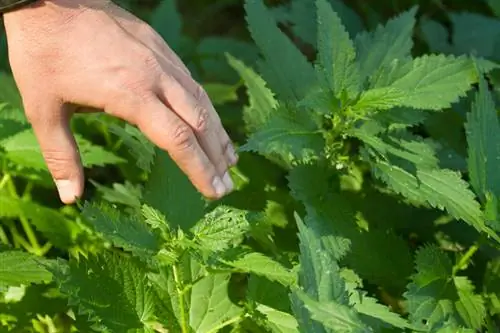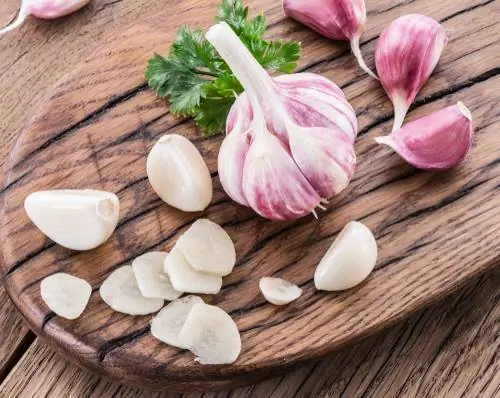- Author admin [email protected].
- Public 2023-12-16 16:46.
- Last modified 2025-01-23 11:22.
It's a myth that spinach shouldn't be reheated. Fresh and frozen spinach can easily be reheated several times. For adults, the nitrate content in warmed spinach is so low that it has no effect on the organism. Only babies should avoid warmed spinach.
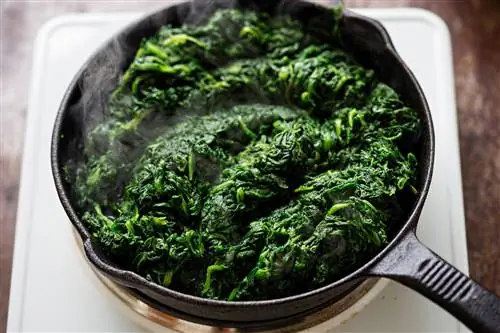
Is it safe to reheat spinach?
Spinach can be reheated safely as long as it is stored hygienically and heated to at least 70 degrees Celsius. When stored properly, nitrate levels and nitrite formation remain harmless to adult consumers.
Can spinach be reheated?
To reassure you right from the start:Yes, spinach can also be reheated after it has been eaten for the first time. This applies to prepared leaf and creamed spinach as well as previously frozen and fresh products. If the right conditions are met, it is even possible to warm up several times. However, the taste and he althy ingredients can be lost. It is advisable to only cook the quantities you need and store the rest in the freezer or refrigerator.
You can recognize bad spinach, both raw and cooked, by an intense stench that is reminiscent of sour milk. In addition, in most cases the leafy vegetables have a discoloration to white or reddish brown. If your spinach has any of the above-mentioned properties, it is strongly advised not to consume it. As a result, there is a risk of diarrhea, vomiting and nausea.
The “warm up spinach” myth
The myth that reheating spinach is dangerous is many decades old. The claim comes from a time when refrigeration of food was not a given. Temperature in particular plays a crucial role in the formation of the harmful substance nitrite. Nowadays, when storing food in refrigerators and freezers is normal, this problem has been defused.
Nitrite and nitrate
Spinach naturally contains a high amount of nitrate, a natural s alt. This is absorbed from the soil as it grows and stored in the leaves. Among other things, nitrate acts as a vasodilator and thus naturally lowers blood pressure. In addition, it stimulates digestion and regulates oxygen transport in the blood. According to nutrition experts, foods with a high nitrate content are therefore essential for a he althy diet. Other well-known representatives of this category include kale, chard, beetroot, arugula and many types of mushrooms.
If stored improperly at room temperature, the valuable ingredient nitrate turns into toxic nitrite. If consumed, this primarily leads to stomach problems. In combination with stomach acid, carcinogenic nitrosamines can also be formed. However, the nitrate itself does not produce any harmful substances, so there is no danger if you follow a few instructions.
The two main drivers for nitrite formation are temperature and hygiene. Only through the action of bacteria does the chemical conversion of nitrate to nitrite occur. Under clean working conditions, the risk of a reaction can be prevented. Complete suppression is only possible at temperatures below 10 degrees Celsius. If this limit is not reached, the bacteria stop their metabolic activity, which leads to no new formation of nitrite. When reheating, care should be taken to reach a sufficiently high temperature in order to kill any pathogens that may be present.
Summarized:
- Preparing spinach in a clean environment
- Place leftovers in a clean bowl and close
- as quickly as possible in the refrigerator or freezer (temperature < 10 degrees Celsius) to cool down
- When heating, heat to at least 70 degrees Celsius to kill bacteria
Tolerance of warmed spinach
Basically, increased intake of nitrite in adolescents and adults usually leads to unpleasant stomach problems. Nitrate poisoning only occurs when the values are significantly elevated. In babies and children, however, the worrying limit is significantly lower because the immune system is not yet fully developed. In the worst case, there is a risk of blue fever. To avoid possible poisoning, you should avoid eating warmed vegetables containing nitrates until you are 12 years old. Freshly prepared spinach, kale, etc. can be eaten without hesitation.
Refreeze thawed spinach?
On the packaging of many frozen products you can find the note “Do not refreeze after defrosting”. But is this really a fact? Essentially, the imprint is a legal safeguard for the manufacturer. By continuously maintaining the cold chain, the accumulation of bacteria and other germs is prevented. This ensures that the producers ensure sterility, the desired taste and the consistency of the frozen product.
Refreezing the spinach is thereforepossible However, if you thaw and refreeze it several times, the vitamin and nutrient concentration decreases. To avoid exposure to bacteria or germs, the product should be heated to at least 70 degrees Celsius.
How to warm up spinach properly
As already mentioned before, warming up the spinach correctly plays a crucial role in tolerability. A minimum temperature of 70 degrees Celsius is recommended, which leads to the death of common bacteria. In addition to the pot, the water bath is also suitable for this.
Theoretically, heating in the microwave is also possible, but special care is required. A common problem with microwaves is irregular heating of food. A completely heated mass is urgently needed to ensure sterility, which is why two passes or regular stirring are advisable with this variant.
In the pot: To avoid burning, we recommend heating the spinach slowly over a low heat. At the same time, a more liquid consistency can be achieved by adding a little water or milk or cream.
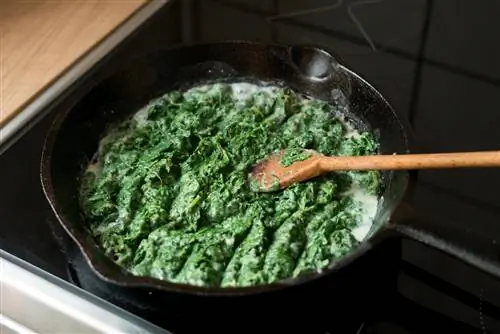
In a water bath: Alternatively, the frozen leafy vegetables can be warmed in a water bath. By avoiding direct contact with the bottom of the pot, burning is completely eliminated.
However, please note that even correctly reheated meals do not last indefinitely. These should be used up after two days at the latest, in order to preserve the taste and consistency.
Shelf life and storage of spinach
Freshly harvested spinach can be stored in the refrigerator for up totwo days. Accordingly, rapid further processing of the leafy vegetables is recommended. In addition to consumption, we also recommend freezing the spinach in order to achieve a longer shelf life. It can be kept frozen for up to 24 months, although losses in color and nutrients can occur after just five to six months. Consumption is generally harmless and not unhe althy.
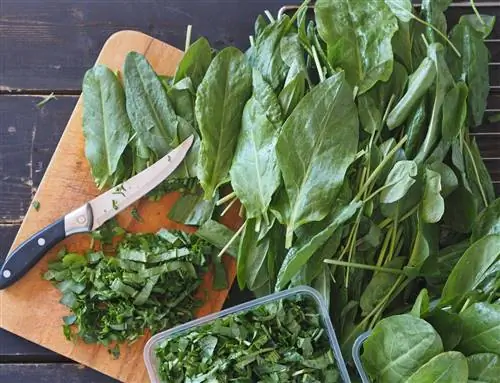
Fresh spinach only has a shelf life of a few days and should therefore be processed as quickly as possible. In addition to short-term consumption, the leafy vegetables can be preserved for longer by freezing.
In order to kill any germs that may be present, the spinach should be blanched before freezing. While the pathogens are killed, the vitamins and nutrients they contain remain present in high numbers.
Instructions:
- Wash spinach thoroughly and portion it
- Bring water to a boil in a pot and add leaves
- Remove the spinach after just a few seconds and put it in a bowl with ice water
- After about two minutes, drain on a kitchen towel
- Dry the leaves well to avoid ice formation
- Place spinach in a suitable shape or bag and store in the freezer
Alternatively, the spinach can be fully cooked before freezing and then pureed. The liquid can then be portioned into molds or an ice cube tray. However, it is important that the container is covered airtight.
Which foods should not be reheated?
Compared to spinach, there are also foods that should no longer be heated. Essentially, these are all those that consist largely of water and proteins. Heating destroys the chemical compounds, resulting in loss of both taste and structure.
Well-known foods in this group are:
- Eggs
- Fish
- Oil
- Mushrooms
The following should be treated with caution:
- Chicken
- Potatoes
- Rice
- Onions
These foods should always be fully cooked during preparation. When reheating, it is also important to ensure that the temperature is clearly exceeded 70 degrees Celsius in order to maintain compatibility.
FAQ
Can you reheat spinach?
Yes, reheating spinach is basically possible. In order to kill any germs that may be present, a minimum temperature of 70 degrees Celsius must be ensured.
Can you reheat spinach several times?
It is possible to reheat spinach several times if it has been cooled correctly beforehand. To do this, it is advisable to pour the mixture into a suitable container immediately after cooking and place it in the refrigerator. However, depending on the frequency of heating, there may be losses in taste, consistency and nutritional content.
Is reheated spinach poisonous?
If you use proper methods when cooling and heating spinach, it is not poisonous. To do this, it is necessary to put the leafy vegetables in the refrigerator early after cooking. During subsequent heating, a temperature of at least 70 degrees Celsius should be maintained for two minutes in order to kill pathogens.
Can babies eat thawed spinach?
In order not to overload the not yet fully developed immune systems of babies and small children, this group of people should avoid eating thawed spinach. Even the smallest amounts of nitrite can lead to poisoning with stomach problems or blueness.
Can you refreeze thawed spinach?
Refreezing spinach is possible if it is stored in the freezer soon after cooking. When reheating, however, care must be taken to ensure that the temperature limit of 70 degrees Celsius is not exceeded. Compared to fresh spinach, there may be differences in color and consistency as well as vitamin and nutrient content.

